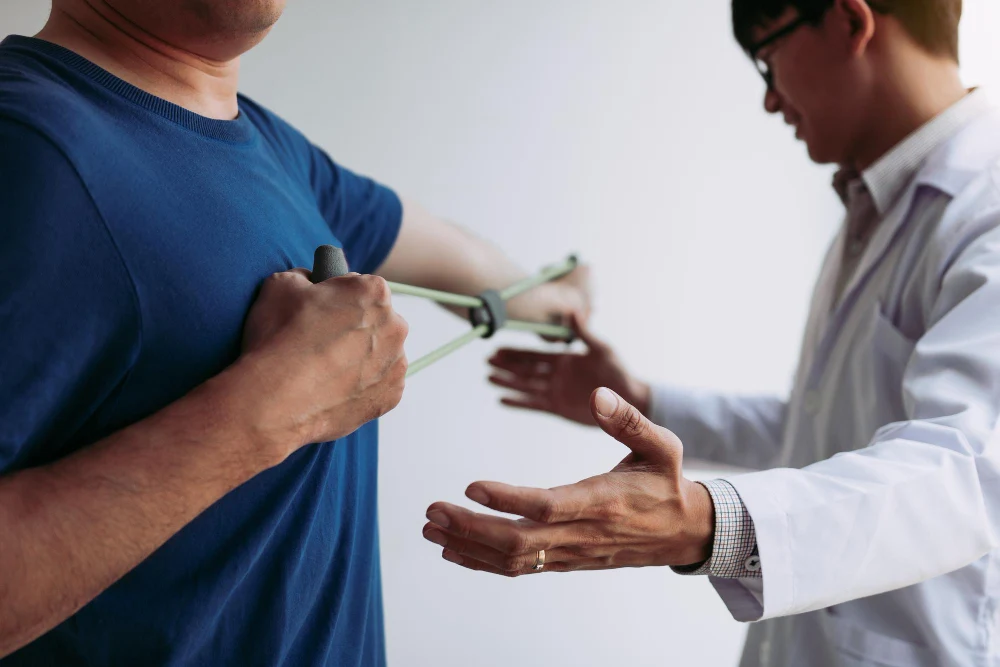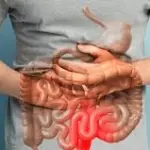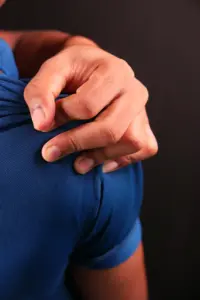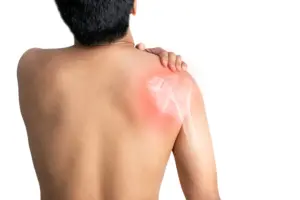Biceps Tenodesis Surgery | Advanced Shoulder Pain Relief
Learn about Biceps Tenodesis surgery for chronic biceps tendon pain. Explore indications, procedure steps, benefits, risks, and recovery guidance from expert orthopedic surgeons.

Biceps Tenodesis Surgery
Biceps Tenodesis Surgery is a procedure used to treat injuries or conditions involving the biceps tendon, typically at the shoulder. The surgery involves reattaching the biceps tendon to a new location on the humerus (upper arm bone) to restore function, alleviate pain, and improve mobility. It’s commonly performed when the biceps tendon becomes damaged or detached, often due to aging, overuse, or a traumatic injury.

Early Detection Saves Lives
Early detection and treatment are crucial for improving the chances of survival. If you notice any concerning symptoms, consult a healthcare provider immediately.
Signs and Symptoms
Pain in the Shoulder
A deep ache in the front of the shoulder, especially when lifting, reaching overhead, or performing activities that involve rotation.
Swelling
Swelling around the upper arm or shoulder joint due to irritation or inflammation of the tendon.
Weakness in the Arm
Difficulty lifting objects or performing strength-dependent tasks, particularly when the arm is rotated or extended.
Tenderness
The area near the biceps tendon, particularly at the front of the shoulder, may be tender to the touch.
Popping or Snapping Sensation
A sudden "pop" or "snap" sound may occur when the tendon is torn or dislocated.
Visible Deformity
In severe cases, you may see a bulging of the biceps muscle, referred to as a "Popeye muscle," caused by the tendon detaching from its usual anchor point.
Blood in Urine
Hematuria - pink, red, or dark urine, the most common symptom
Frequent Urination
Feeling the need to urinate frequently, even when bladder is not full
Painful Urination
Experiencing pain or burning sensation while urinating
Back or Pelvic Pain
Pain that occurs as the cancer grows and spreads
Unexplained Weight Loss
Significant weight loss not related to diet or exercise
Fatigue
Feeling unusually tired or weak without a clear cause
Meet Our Expert Biceps Tenodesis Surgeons
Risk Factors
Smoking
Smoking is one of the leading causes of bladder cancer. Chemicals in tobacco smoke can damage the lining of the bladder, increasing the risk.

Gender
Men are at a higher risk of developing bladder cancer than women.

Chronic Bladder Infections or Inflammation
Conditions such as bladder infections and long-term bladder inflammation can increase the risk.

Exposure to Chemicals
Prolonged exposure to certain chemicals, especially those used in the dye industry, rubber production, and chemical manufacturing, increases the risk.

Age
Tendon degeneration increases as we age, particularly for individuals over 40. The biceps tendon becomes less elastic, making it more susceptible to tearing.

Repetitive Stress
Engaging in repetitive overhead movements, such as lifting weights, swimming, or throwing, can lead to chronic wear and tear on the tendon.

Previous Shoulder Injuries
Individuals with prior shoulder injuries or conditions like rotator cuff tears or shoulder instability are more likely to suffer from biceps tendon issues.

Smoking
Smoking can impede blood flow and delay healing, increasing the risk of tendon degeneration.

Weak Muscles
Weak shoulder or arm muscles put more strain on the biceps tendon, making it more prone to injury.

Genetics
Some individuals may have a genetic predisposition to tendon issues due to inherited connective tissue conditions.

Biceps Tenodesis Surgery
Diet and Nutrition
Prevention
Diagnosis
Key Services
Key Facilities
- Protein: Consuming adequate protein helps with muscle repair and recovery. Lean meats, eggs, legumes, and tofu are good sources of protein.
- Vitamin C: Vitamin C plays a crucial role in collagen production, which is vital for tendon healing. Include citrus fruits, strawberries, and bell peppers in your diet.
- Omega-3 Fatty Acids: Foods rich in omega-3s, such as fatty fish (salmon, mackerel), walnuts, and flaxseeds, have anti-inflammatory properties that help with tendon healing.
- Vitamin D and Calcium: Bone and tendon health depend on calcium and Vitamin D, which promote healing and strength. Dairy products, fortified foods, and sunlight are great sources.
- Zinc: Zinc is involved in tissue repair and regeneration. Foods like nuts, seeds, and lean meats provide good amounts of zinc.
- Hydration: Staying hydrated is essential for overall recovery, as dehydration can slow down the healing process.
- Magnesium: Magnesium helps to reduce muscle cramps and supports overall muscle function. Include leafy greens, nuts, and whole grains in your diet.
- Warm-Up and Stretching: Before engaging in physical activity, ensure you properly warm up and stretch the muscles around the shoulder, focusing on flexibility.
- Strengthening Exercises: Perform regular strength training exercises that target the shoulder muscles, including the rotator cuff and biceps, to support tendon health.
- Use Proper Technique: Pay attention to form when lifting weights, playing sports, or performing repetitive tasks to reduce strain on the shoulder tendons.
- Avoid Overuse: Don’t push through pain during physical activity. Overuse can lead to tendon damage, so take regular breaks and allow your body time to rest.
- Correct Posture: Maintain proper posture during daily activities to avoid unnecessary stress on the shoulder joint and tendons.
- Wear Appropriate Gear: In certain sports, such as tennis or baseball, using proper protective gear, like shoulder supports, can help prevent biceps tendon injury.
- Physical Examination: A doctor will perform a thorough physical exam to assess pain, tenderness, and range of motion in the shoulder. They may test the strength and stability of the shoulder joint.
- MRI (Magnetic Resonance Imaging): An MRI provides detailed images of the shoulder tendons, including the biceps tendon, and is useful for identifying tears, inflammation, or other soft tissue damage.
- X-rays: While X-rays cannot detect soft tissue injuries like tendon tears, they can rule out bone fractures or arthritis that might be contributing to the symptoms.
- Ultrasound: In some cases, an ultrasound is used to visualize the tendon and identify any tears or abnormalities in real-time.
- Arthroscopy: If the diagnosis is unclear or if a more detailed assessment is needed, an arthroscopic procedure may be performed, where a tiny camera is inserted into the joint to directly examine the tendon.
- Preoperative Consultation: A thorough evaluation of the patient’s medical history, physical exam, and imaging results to determine if surgery is necessary.
- Surgical Procedure: Biceps tenodesis is typically done arthroscopically, where small incisions are made, and the tendon is reattached to a new location on the humerus using sutures or anchors.
- Postoperative Rehabilitation: A personalized physical therapy program is essential to restore function and mobility to the shoulder after surgery. The rehab process typically includes strengthening exercises, range-of-motion work, and functional training.
- Pain Management: Management of post-surgical pain through medications, ice therapy, and elevation.
- Follow-Up Care: Regular check-ups to monitor the healing process, assess any complications, and adjust the rehabilitation plan accordingly.
- Orthopedic Surgeons Specializing in Shoulder Surgery: Ensuring that the procedure is performed by a highly trained orthopedic surgeon with specific expertise in shoulder surgeries like biceps tenodesis.
- Advanced Imaging Technology: MRI, X-ray, and ultrasound capabilities to diagnose the tendon injury accurately and plan the surgery.
- Surgical Suite with Arthroscopic Equipment: A well-equipped operating room for minimally invasive arthroscopic surgery.
- Physical Therapy Centers: Access to specialized rehabilitation facilities with physical therapists experienced in shoulder recovery.
- Postoperative Care Units: Ensuring that patients receive proper care after the surgery, including pain management, infection prevention, and early mobilization.
Top Medical Facilities at Our Multispeciality Hospital – Here’s What Makes Us Different!
Ready to Start Your Biceps Tendon Injury Recovery Journey?
Learn More About Biceps Tendon Injury Care
Frequently Asked Questions
Recovery from biceps tenodesis surgery typically takes about 4 to 6 months. The first few weeks focus on rest and gentle mobility exercises, followed by strengthening exercises in physical therapy. Most people return to light activities around 3-4 months and full recovery can be expected by 6 months.
After surgery, you may experience some discomfort, swelling, and limited mobility. A sling is usually worn for 2-4 weeks, and physical therapy will be initiated shortly after to help regain strength and range of motion. Most patients experience gradual improvement over several months.
While you can return to weight lifting after rehabilitation, it’s crucial to follow the guidance of your surgeon and physical therapist. Full recovery can take up to 6 months, and lifting heavy weights too soon can lead to reinjury. Always consult your healthcare provider before resuming intense workouts.
